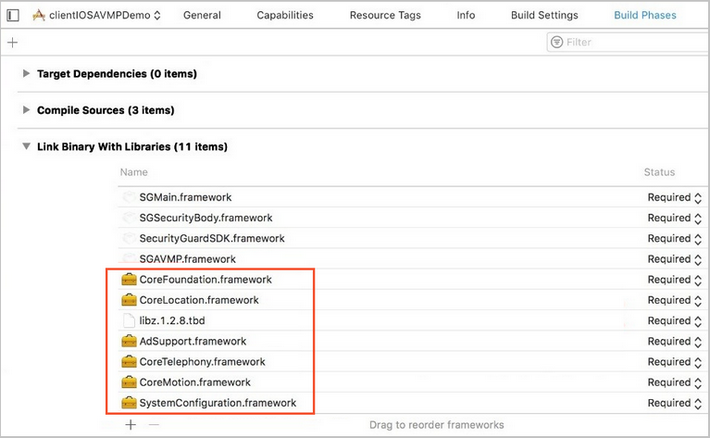This topic describes how to integrate the Anti-Bot SDK into iOS applications.
SDK files for iOS applications
Contact Alibaba Cloud technical support to obtain the SDK package, and decompress it on your local machine. The following table describes the files contained in the sdk-iOS folder.
| File name | Description |
|---|---|
| SGMain.framework | The main framework. |
| SecurityGuardSDK.framework | The basic security plug-in. |
| SGSecurityBody.framework | The bot recognition plug-in. |
| SGAVMP.framework | The virtual machine engine plug-in. |
| yw_1222_0335_mwua.jpg | Configuration files. |
Configure an iOS project
- Import the SDK dependency files. Import the following four .framework files extracted
from the SDK package to the dependency library in an iOS project. The dependency library
locates in the Link Binary With Libraries menu on the Build Phases tab.
- SGMain.framework
- SecurityGuardSDK.framework
- SGSecurityBody.framework
- SGAVMP.framework

- Add link options. On the Build Settings tab, choose to set the value to -ObjC.

- Import system dependency files. Import these files to the dependency library of an
iOS project:
- CoreFoundation.framework
- CoreLocation.framework
- AdSupport.framework
- CoreTelephony.framework
- CoreMotion.framework
- SystemConfiguration.framework

- Import the configuration file. Add the yw_1222_0335_mwua.jpg configuration file in the SDK package to the mainbundle directory.
Notice When the application integrates multiple targets, make sure to add the
yw_1222_0335_mwua.jpgconfiguration file to the correct target membership.
Call the SDK
Step 1: Initialize the SDK
Endpoint: + (BOOL) initialize;
Function: Initializes the SDK.
Parameters: None.
Responses: Boolean. YES is returned if the initialization is successful. NO is returned if the initialization fails.
Call methods: [JAQAVMPSignature initialize];
static BOOL avmpInit = NO;
- (BOOL) initAVMP{
@synchronized(self) { // just initialize once
if(avmpInit == YES){
return YES;
}
avmpInit = [JAQAVMPSignature initialize];
return avmpInit;
}
}Step 2: Sign the request
Endpoints: + (NSData*) avmpSign: (NSInteger) signType input: (NSData*) input;
| Parameter | Type | Required | Description |
|---|---|---|---|
| signType | NSInteger | Yes | The algorithm used to sign the request. Set the value to 3.
|
| input | NSData* | No | The data to be signed, which is typically the entire request body.
Note If the request body is empty, for example, an empty POST or GET request body, enter
null or the value of the Bytes parameter.
|
Responses: A signature string is returned.
Call methods: [JAQAVMPSignature avmpSign: 3 input: request_body];
# define VMP_SIGN_WITH_GENERAL_WUA2 (3)
- (NSString*) avmpSign{
@synchronized(self) {
NSString* request_body = @"i am the request body, encrypted or not!" ;
if(![ self initAVMP]){
[self toast:@"Error: init failed"];
return nil;
}
NSString* wToken = null;
NSData* data = [request_body dataUsingEncoding:NSUTF8StringEncoding];
NSData* sign = [JAQAVMPSignature avmpSign: VMP_SIGN_WITH_GENERAL_WUA2 input:data];
if(sign == nil || sign.length <= 0){
return nil;
}else{
wToken = [[NSString alloc] initWithData:sign encoding: NSUTF8StringEncoding];
return wToken;
}
}
}NSData* sign = [JAQAVMPSignature avmpSign: VMP_SIGN_WITH_GENERAL_WUA2 input:null];Step 3: Add wToken to the protocol header
#define VMP_SIGN_WITH_GENERAL_WUA2 (3)
-(void)setHeader
{ NSString* request_body = @"i am the request body, encrypted or not!" ;
NSData* body_data = [request_body dataUsingEncoding:NSUTF8StringEncoding];
NSString* wToken = nil;
NSData* sign = [JAQAVMPSignature avmpSign: VMP_SIGN_WITH_GENERAL_WUA2 input:body_data];
wToken = [[NSString alloc] initWithData:sign encoding: NSUTF8StringEncoding];
NSString *strUrl = [NSString stringWithFormat:@"http://www.aliyundoc.com/login"];
NSURL *url = [NSURL URLWithString:strUrl];
NSMutableURLRequest *request =
[[NSMutableURLRequest alloc]initWithURL:url cachePolicy:NSURLRequestReloadIgnoringCacheData timeoutInterval:20];
[request setHTTPMethod:@"POST"];
// set request body info
[request setHTTPBody:body_data];
// set wToken info to header
[request setValue:wToken forHTTPHeaderField:@"wToken"];
NSURLConnection *mConn = [[NSURLConnection alloc]initWithRequest:request delegate:self startImmediately:true];
[mConn start];
// ...
}Step 4: Send data to the server
Send the data with the modified protocol header to Alibaba Cloud Security, which analyzes the wToken for risk identification and malicious request interception, and then forwards valid requests to the origin server.
Error code
Errors may occur when you call the initialize and avmpSign operations. If the system fails to generate a valid signature string, see the information about security guard errors in the console.
The following table lists the common error codes and their descriptions.
| Error code | Description |
|---|---|
| 1901 | The error code returned because the parameters are invalid. Check the parameters. |
| 1902 | The error code returned because the image file is invalid. The image may not match the bundle ID. |
| 1903 | The error code returned because the format of the image file is invalid. |
| 1904 | Upgrade the image version. The AVMP signature function only supports v5 images. |
| 1905 | The error code returned because the specified image file cannot be found. Make sure that the yw_1222_0335_mwua.jpg image file has been correctly added to the project. |
| 1906 | The error code returned because the AVMP signature of the image does not have the required bytecode. Check whether the image is invalid. |
| 1907 | The error code returned because the initialization of AVMP failed. Try again later. |
| 1910 | The error code returned because the AVMP instance is invalid. Possible causes include:
|
| 1911 | The byteCode of the encrypted image does not have the corresponding export function. |
| 1912 | The error code returned because the system failed to call AVMP. Contact Alibaba Cloud technical support. |
| 1913 | The error code returned because the InvokeAVMP method was called after the AVMP instance had been destroyed. |
| 1915 | The error code returned because the memory resources of the AVMP instance are insufficient. Try again later. |
| 1999 | The error code returned because an unknown error occurred. Try again later. |